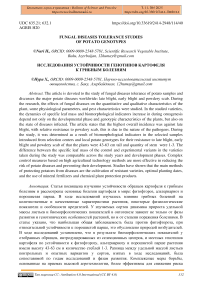Fungal Diseases Tolerance Studies of Potato Genotypes
Автор: Nuri H.
Журнал: Бюллетень науки и практики @bulletennauki
Рубрика: Сельскохозяйственные науки
Статья в выпуске: 5 т.11, 2025 года.
Бесплатный доступ
The article is devoted to the study of fungal diseases tolerance of potato samples and discusses the major potato diseases worldwide: late blight, early blight and powdery scab. During the research, the effects of fungal diseases on the quantitative and qualitative characteristics of the plant, some physiological parameters, and pest characteristics were studied. In the studied varieties, the dynamics of specific leaf mass and biomorphological indicators increase in during ontogenesis depend not only on the developmental phase and genotypic characteristics of the plants, but also on the state of diseases infected. The article states that the highest overall incidence was against late blight, with relative resistance to powdery scab, this is due to the nature of the pathogens. During the study, it was determined as a result of biomorphological indicators in the selected samples introduced from selection centers and local potato genotypes for their resistance to late blight, early blight and powdery scab of that the plants were 43-63 cm tall and quantity of stem were 1-3. The difference between the specific leaf mass of the control and experimental variants in the varieties taken during the study was comparable across the study years and development phases. Complex control measures based on high agricultural technology methods are more effective in reducing the risk of potato diseases and preventing their development. Studies have shown that the main methods of protecting potatoes from diseases are the cultivation of resistant varieties, optimal planting dates, and the use of mineral fertilizers and chemical plant protection products.
Potato, fungal diseases, selection, resistant varieties
Короткий адрес: https://sciup.org/14132425
IDR: 14132425 | УДК: 635.21; 632.1 | DOI: 10.33619/2414-2948/114/40
Текст научной статьи Fungal Diseases Tolerance Studies of Potato Genotypes
Бюллетень науки и практики / Bulletin of Science and Practice
UDC 635.21; 632.1
Potato ( Solanum tuberosum ) is the third most important crop for human consumption in the world, after rice and wheat. Increasing the production and improving the quality of agricultural products, including potato, plays a key role in ensuring the food security of the country's population. Potato is among the high-income crops globally and can contribute to poverty reduction in developing regions. The need to increase agricultural efficiency and intensify agricultural production makes the selection of new disease-resistant varieties of exceptional importance. Since potatoes are one of the most important food sources, the main goal of breeding work with this plant is to create new varieties with high yield potential and adaptive characteristics adapted to the ecological conditions of a particular climatic zone [1].
One of the most important problems in the cultivation of potato plants is their susceptibility to diseases [7]. The effect of pathogens on plants depends on the physiological characteristics of the plant and the conditions that arise after exposure to the pathogen. Of particular importance in the agricultural sector is the cultivation of high-quality seeds to obtain high-quality yields of agricultural crop varieties through the introduction of innovative technologies [3, 4].
The process of photosynthesis plays a key role in the formation of biological products of plants. This process depends on the genotype of the plant, cultivation conditions, and the resistance of the plant to diseases. Resistant genotypes can protect themselves from the effects of stress by maintaining high photosynthetic activity.
The negative impact of diseases on plant leaves is a limiting physiological factor that prevents potato cultivation in many countries of the world. The growth and development of potatoes, the collection of tuber yields largely depend on their physiological characteristics. This dependence is more pronounced in potatoes than in other plant species. Narrowing of the leaf surface and the destruction of photosynthetic pigments reduce photosynthetic activity, inhibit the onset of stolon growth and tuber formation [2, 9].
One of the main goals of the research was to study the morphophysiological dimensions and yield components of potato genotypes during the vegetation period, which allows for the selection of high-yielding and disease-resistant genotypes.
The expansion of potato cultivation areas in farms due to the transition to a market economy requires the creation of competitive, productive varieties. Therefore, it is important to obtain specimens that are resistant to diseases and provide stable yields [8].
Material and methodology
The main purpose of the research is to study the effects of fungal diseases and pest characteristics on local and introduced potato samples, to evaluate local and introduced potato genotypes for durability, to select resistant and tolerant genotypes, to study the effect of diseases on physiological parameters and productivity in local and foreign varieties .
Samples with a high relative water content of leaves have many advantages during the vegetation period. Thus, water is considered the main chemical component of cells. It plays the role
Бюллетень науки и практики / Bulletin of Science and Practice Т. 11. №5 2025 of a medium for most biochemical reactions. In environments with a low water content, metabolism weakens. When there is a lack of water, photosynthesis weakens rapidly, while respiration, on the contrary, becomes more intense. Weakening of photosynthesis and strengthening of the respiratory process ultimately leads to a decrease in yield [6].


